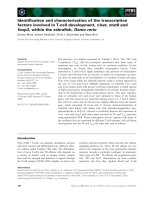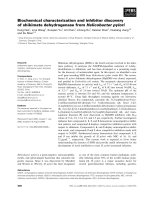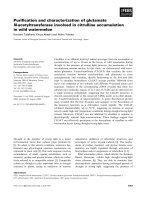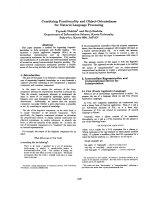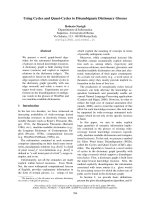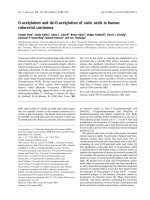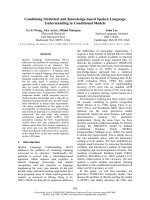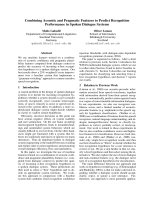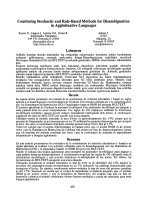Báo cáo khoa học: "Combining Linguistic and Gaze Features to Resolve Second-Person References in Dialogue" docx
Bạn đang xem bản rút gọn của tài liệu. Xem và tải ngay bản đầy đủ của tài liệu tại đây (182.92 KB, 9 trang )
Proceedings of the 12th Conference of the European Chapter of the ACL, pages 273–281,
Athens, Greece, 30 March – 3 April 2009.
c
2009 Association for Computational Linguistics
Who is “You”? Combining Linguistic and Gaze Features to Resolve
Second-Person References in Dialogue
∗
Matthew Frampton
1
, Raquel Fern
´
andez
1
, Patrick Ehlen
1
, Mario Christoudias
2
,
Trevor Darrell
2
and Stanley Peters
1
1
Center for the Study of Language and Information, Stanford University
{frampton, raquelfr, ehlen, peters}@stanford.edu
2
International Computer Science Institute, University of California at Berkeley
,
Abstract
We explore the problem of resolving the
second person English pronoun you in
multi-party dialogue, using a combination
of linguistic and visual features. First, we
distinguish generic and referential uses,
then we classify the referential uses as ei-
ther plural or singular, and finally, for the
latter cases, we identify the addressee. In
our first set of experiments, the linguistic
and visual features are derived from man-
ual transcriptions and annotations, but in
the second set, they are generated through
entirely automatic means. Results show
that a multimodal system is often prefer-
able to a unimodal one.
1 Introduction
The English pronoun you is the second most fre-
quent word in unrestricted conversation (after I
and right before it).
1
Despite this, with the ex-
ception of Gupta et al. (2007b; 2007a), its re-
solution has received very little attention in the lit-
erature. This is perhaps not surprising since the
vast amount of work on anaphora and reference
resolution has focused on text or discourse - medi-
ums where second-person deixis is perhaps not
as prominent as it is in dialogue. For spoken di-
alogue pronoun resolution modules however, re-
solving you is an essential task that has an impor-
tant impact on the capabilities of dialogue summa-
rization systems.
∗
We thank the anonymous EACL reviewers, and Surabhi
Gupta, John Niekrasz and David Demirdjian for their com-
ments and technical assistance. This work was supported by
the CALO project (DARPA grant NBCH-D-03-0010).
1
See e.g. />Besides being important for computational im-
plementations, resolving you is also an interesting
and challenging research problem. As for third
person pronouns such as it, some uses of you are
not strictly referential. These include discourse
marker uses such as you know in example (1), and
generic uses like (2), where you does not refer to
the addressee as it does in (3).
(1) It’s not just, you know, noises like something
hitting.
(2) Often, you need to know specific button se-
quences to get certain functionalities done.
(3) I think it’s good. You’ve done a good review.
However, unlike it, you is ambiguous between sin-
gular and plural interpretations - an issue that is
particularly problematic in multi-party conversa-
tions. While you clearly has a plural referent in
(4), in (3) the number of its referent is ambigu-
ous.
2
(4) I don’t know if you guys have any questions.
When an utterance contains a singular referen-
tial you, resolving the you amounts to identifying
the individual to whom the utterance is addressed.
This is trivial in two-person dialogue since the cur-
rent listener is always the addressee, but in conver-
sations with multiple participants, it is a complex
problem where different kinds of linguistic and vi-
sual information play important roles (Jovanovic,
2007). One of the issues we investigate here is
2
In contrast, the referential use of the pronoun it (as well
as that of some demonstratives) is ambiguous between NP
interpretations and discourse-deictic ones (Webber, 1991).
273
how this applies to the more concrete problem of
resolving the second person pronoun you.
We approach this issue as a three-step prob-
lem. Using the AMI Meeting Corpus (McCowan
et al., 2005) of multi-party dialogues, we first dis-
criminate between referential and generic uses of
you. Then, within the referential uses, we dis-
tinguish between singular and plural, and finally,
we resolve the singular referential instances by
identifying the intended addressee. We use multi-
modal features: initially, we extract discourse fea-
tures from manual transcriptions and use visual in-
formation derived from manual annotations, but
then we move to a fully automatic approach, us-
ing 1-best transcriptions produced by an automatic
speech recognizer (ASR) and visual features auto-
matically extracted from raw video.
In the next section of this paper, we give a brief
overview of related work. We describe our data in
Section 3, and explain how we extract visual and
linguistic features in Sections 4 and 5 respectively.
Section 6 then presents our experiments with man-
ual transcriptions and annotations, while Section
7, those with automatically extracted information.
We end with conclusions in Section 8.
2 Related Work
2.1 Reference Resolution in Dialogue
Although the vast majority of work on reference
resolution has been with monologic text, some re-
cent research has dealt with the more complex
scenario of spoken dialogue (Strube and M
¨
uller,
2003; Byron, 2004; Arstein and Poesio, 2006;
M
¨
uller, 2007). There has been work on the iden-
tification of non-referential uses of the pronoun it:
M
¨
uller (2006) uses a set of shallow features au-
tomatically extracted from manual transcripts of
two-party dialogue in order to train a rule-based
classifier, and achieves an F-score of 69%.
The only existing work on the resolution of you
that we are aware of is Gupta et al. (2007b; 2007a).
In line with our approach, the authors first disam-
biguate between generic and referential you, and
then attempt to resolve the reference of the ref-
erential cases. Generic uses of you account for
47% of their data set, and for the generic vs. ref-
erential disambiguation, they achieve an accuracy
of 84% on two-party conversations and 75% on
multi-party dialogue. For the reference resolution
task, they achieve 47%, which is 10 points over
a baseline that always classifies the next speaker
as the addressee. These results are achieved with-
out visual information, using manual transcripts,
and a combination of surface features and manu-
ally tagged dialogue acts.
2.2 Addressee Detection
Resolving the referential instances of you amounts
to determining the addressee(s) of the utterance
containing the pronoun. Recent years have seen
an increasing amount of research on automatic
addressee detection. Much of this work focuses
on communication between humans and computa-
tional agents (such as robots or ubiquitous com-
puting systems) that interact with users who may
be engaged in other activities, including interac-
tion with other humans. In these situations, it
is important for a system to be able to recognize
when it is being addressed by a user. Bakx et
al. (2003) and Turnhout et al. (2005) studied this
issue in the context of mixed human-human and
human-computer interaction using facial orienta-
tion and utterance length as clues for addressee
detection, while Katzenmaier et al. (2004) inves-
tigated whether the degree to which a user utter-
ance fits the language model of a conversational
robot can be useful in detecting system-addressed
utterances. This research exploits the fact that hu-
mans tend to speak differently to systems than to
other humans.
Our research is closer to that of Jovanovic
et al. (2006a; 2007), who studied addressing in
human-human multi-party dialogue. Jovanovic
and colleagues focus on addressee identification in
face-to-face meetings with four participants. They
use a Bayesian Network classifier trained on sev-
eral multimodal features (including visual features
such as gaze direction, discourse features such as
the speaker and dialogue act of preceding utter-
ances, and utterance features such as lexical clues
and utterance duration). Using a combination of
features from various resources was found to im-
prove performance (the best system achieves an
accuracy of 77% on a portion of the AMI Meeting
Corpus). Although this result is very encouraging,
it is achieved with the use of manually produced
information - in particular, manual transcriptions,
dialogue acts and annotations of visual focus of at-
tention. One of the issues we aim to investigate
here is how automatically extracted multimodal
information can help in detecting the addressee(s)
of you-utterances.
274
Generic Referential Ref Sing. Ref Pl.
49.14% 50.86% 67.92% 32.08%
Table 1: Distribution of you interpretations
3 Data
Our experiments are performed using the AMI
Meeting Corpus (McCowan et al., 2005), a collec-
tion of scenario-driven meetings among four par-
ticipants, manually transcribed and annotated with
several different types of information (including
dialogue acts, topics, visual focus of attention, and
addressee). We use a sub-corpus of 948 utterances
containing you, and these were extracted from 10
different meetings. The you-utterances are anno-
tated as either discourse marker, generic or refer-
ential.
We excluded the discourse marker cases, which
account for only 8% of the data, and of the refer-
ential cases, selected those with an AMI addressee
annotation.
3
The addressee of a dialogue act can
be unknown, a single meeting participant, two
participants, or the whole audience (three partici-
pants in the AMI corpus). Since there are very few
instances of two-participant addressee, we distin-
guish only between singular and plural addressees.
The resulting distribution of classes is shown in
Table 1.
4
We approach the reference resolution task as a
two-step process, first discriminating between plu-
ral and singular references, and then resolving the
reference of the singular cases. The latter task re-
quires a classification scheme for distinguishing
between the three potential addressees (listeners)
for the given you-utterance.
In their four-way classification scheme,
Gupta et al. (2007a) label potential addressees in
terms of the order in which they speak after the
you-utterance. That is, for a given you-utterance,
the potential addressee who speaks next is labeled
1, the potential addressee who speaks after that is
2, and the remaining participant is 3. Label 4 is
used for group addressing. However, this results
in a very skewed class distribution because the
next speaker is the intended addressee 41% of
the time, and 38% of instances are plural - the
3
Addressee annotations are not provided for some dia-
logue act types - see (Jovanovic et al., 2006b).
4
Note that the percentages of the referential singular and
referential plural are relative to the total of referential in-
stances.
L
1
L
2
L
3
35.17% 30.34% 34.49%
Table 2: Distribution of addressees for singular you
remaining two classes therefore make up a small
percentage of the data.
We were able to obtain a much less skewed class
distribution by identifying the potential addressees
in terms of their position in relation to the current
speaker. The meeting setting includes a rectangu-
lar table with two participants seated at each of
its opposite longer sides. Thus, for a given you-
utterance, we label listeners as either L
1
, L
2
or
L
3
depending on whether they are sitting opposite,
diagonally or laterally from the speaker. Table 2
shows the resulting class distribution for our data-
set. Such a labelling scheme is more similar to Jo-
vanovic (2007), where participants are identified
by their seating position.
4 Visual Information
4.1 Features from Manual Annotations
We derived per-utterance visual features from the
Focus Of Attention (FOA) annotations provided
by the AMI corpus. These annotations track meet-
ing participants’ head orientation and eye gaze
during a meeting.
5
Our first step was to use the
FOA annotations in order to compute what we re-
fer to as Gaze Duration Proportion (GDP) values
for each of the utterances of interest - a measure
similar to the “Degree of Mean Duration of Gaze”
described by (Takemae et al., 2004). Here a GDP
value denotes the proportion of time in utterance u
for which subject i is looking at target j:
GDP
u
(i, j) =
j
T (i, j)/T
u
were T
u
is the length of utterance u in millisec-
onds, and T (i, j), the amount of that time that i
spends looking at j. The gazer i can only refer to
one of the four meeting participants, but the tar-
get j can also refer to the white-board/projector
screen present in the meeting room. For each utter-
ance then, all of the possible values of i and j are
used to construct a matrix of GDP values. From
this matrix, we then construct “Highest GDP” fea-
tures for each of the meeting participants: such
5
A description of the FOA labeling scheme is avail-
able from the AMI Meeting Corpus website http://corpus.
amiproject.org/documentations/guidelines-1/
275
For each participant Pi
– target for whole utterance
– target for first third of utterance
– target for second third of utterance
– target for third third of utterance
– target for -/+ 2 secs from you start time
– ratio 2nd hyp. target / 1st hyp. target
– ratio 3rd hyp. target / 1st hyp. target
– participant in mutual gaze with speaker
Table 3: Visual Features
features record the target with the highest GDP
value and so indicate whom/what the meeting par-
ticipant spent most time looking at during the ut-
terance.
We also generated a number of additional fea-
tures for each individual. These include firstly,
three features which record the candidate “gazee”
with the highest GDP during each third of the ut-
terance, and which therefore account for gaze tran-
sitions. So as to focus more closely on where par-
ticipants are looking around the time when you
is uttered, another feature records the candidate
with the highest GDP -/+ 2 seconds from the start
time of the you. Two further features give some
indication of the amount of looking around that
the speaker does during an utterance - we hypoth-
esized that participants (especially the speaker)
might look around more in utterances with plu-
ral addressees. The first is the ratio of the sec-
ond highest GDP to the highest, and the second
is the ratio of the third highest to the highest. Fi-
nally, there is a highest GDP mutual gaze feature
for the speaker, indicating with which other indi-
vidual, the speaker spent most time engaged in a
mutual gaze.
Hence this gives a total of 29 features: seven
features for each of the four participants, plus one
mutual gaze feature. They are summarized in Ta-
ble 3. These visual features are different to those
used by Jovanovic (2007) (see Section 2). Jo-
vanovic’s features record the number of times that
each participant looks at each other participant
during the utterance, and in addition, the gaze di-
rection of the current speaker. Hence, they are not
highest GDP values, they do not include a mutual
gaze feature and they do not record whether par-
ticipants look at the white-board/projector screen.
4.2 Automatic Features from Raw Video
To perform automatic visual feature extraction, a
six degree-of-freedom head tracker was run over
each subject’s video sequence for the utterances
containing you. For each utterance, this gave 4 se-
quences, one per subject, of the subject’s 3D head
orientation and location at each video frame along
with 3D head rotational velocities. From these
measurements we computed two types of visual
information: participant gaze and mutual gaze.
The 3D head orientation and location of each
subject along with camera calibration information
was used to compute participant gaze information
for each video frame of each sequence in the form
of a gaze probability matrix. More precisely, cam-
era calibration is first used to estimate the 3D head
orientation and location of all subjects in the same
world coordinate system.
The gaze probability matrix is a 4 × 5 matrix
where entry i, j stores the probability that subject
i is looking at subject j for each of the four sub-
jects and the last column corresponds to the white-
board/projector screen (i.e., entry i, j where j = 5
is the probability that subject i is looking at the
screen). Gaze probability G(i, j) is defined as
G(i, j) = G
0
e
−α
i,j
2/γ2
where α
i,j
is the angular difference between the
gaze of subject i and the direction defined by the
location of subjects i and j. G
0
is a normalization
factor such that
j
G(i, j) = 1 and γ is a user-
defined constant (in our experiments, we chose
γ = 15 degrees).
Using the gaze probability matrix, a 4 × 1 per-
frame mutual gaze vector was computed that for
entry i stores the probability that the speaker and
subject i are looking at one another.
In order to create features equivalent to those
described in Section 4.1, we first collapse the
frame-level probability matrix into a matrix of bi-
nary values. We convert the probability for each
frame into a binary judgement of whether subject
i is looking at target j:
H(i, j) = βG(i, j)
β is a binary value to evaluate G(i, j) > θ, where
θ is a high-pass thresholding value - or “gaze prob-
ability threshold” (GPT) - between 0 and 1.
Once we have a frame-level matrix of binary
values, for each subject i, we compute GDP val-
ues for the time periods of interest, and in each
case, choose the target with the highest GDP as the
candidate. Hence, we compute a candidate target
for the utterance overall, for each third of the ut-
terance, and for the period -/+ 2 seconds from the
276
you start time, and in addition, we compute a can-
didate participant for mutual gaze with the speaker
for the utterance overall.
We sought to use the GPT threshold which pro-
duces automatic visual features that agree best
with the features derived from the FOA annota-
tions. Hence we experimented with different GPT
values in increments of 0.1, and compared the re-
sulting features to the manual features using the
kappa statistic. A threshold of 0.6 gave the best
kappa scores, which ranged from 20% to 44%.
6
5 Linguistic Information
Our set of discourse features is a simplified ver-
sion of those employed by Galley et al. (2004) and
Gupta et al. (2007a). It contains three main types
(summarized in Table 4):
— Sentential features (1 to 13) encode structural,
durational, lexical and shallow syntactic patterns
of the you-utterance. Feature 13 is extracted us-
ing the AMI “Named Entity” annotations and in-
dicates whether a particular participant is men-
tioned in the you-utterance. Apart from this fea-
ture, all other sentential features are automatically
extracted, and besides 1, 8, 9, and 10, they are all
binary.
— Backward Looking (BL)/Forward Looking (FL)
features (14 to 22) are mostly extracted from ut-
terance pairs, namely the you-utterance and the
BL/FL (previous/next) utterance by each listener
L
i
(potential addressee). We also include a few
extra features which are not computed in terms of
utterance pairs. These indicate the number of par-
ticipants that speak during the previous and next 5
utterances, and the BL and FL speaker order. All
of these features are computed automatically.
— Dialogue Act (DA) features (23 to 24) use the
manual AMI dialogue act annotations to represent
the conversational function of the you-utterance
and the BL/FL utterance by each potential ad-
dressee. Along with the sentential feature based
on the AMI Named Entity annotations, these are
the only discourse features which are not com-
puted automatically.
7
6
The fact that our gaze estimator is getting any useful
agreement with respect to these annotations is encouraging
and suggests that an improved tracker and/or one that adapts
to the user more effectively could work very well.
7
Since we use the manual transcripts of the meetings, the
transcribed words and the segmentation into utterances or di-
alogue acts are of course not given automatically. A fully
automatic approach would involve using ASR output instead
of manual transcriptions— something which we attempt in
(1) # of you pronouns
(2) you (say|said|tell|told| mention(ed)|mean(t)|
sound(ed))
(3) auxiliary you
(4) wh-word you
(5) you guys
(6) if you
(7) you know
(8) # of words in you-utterance
(9) duration of you-utterance
(10) speech rate of you-utterance
(11) 1st person
(12) general case
(13) person Named Entity tag
(14) # of utterances between you- and BL/FL utt.
(15) # of speakers between you- and BL/FL utt.
(16) overlap between you- and BL/FL utt. (binary)
(17) duration of overlap between you- and BL/FL utt.
(18) time separation between you- and BL/FL utt.
(19) ratio of words in you- that are in BL/FL utt.
(20) # of participants that speak during prev. 5 utt.
(21) # of participants that speak during next 5 utt.
(22) speaker order BL/FL
(23) dialogue act of the you-utterance
(24) dialogue act of the BL/FL utterance
Table 4: Discourse Features
6 First Set of Experiments & Results
In this section we report our experiments and re-
sults when using manual transcriptions and anno-
tations. In Section 7 we will present the results
obtained using ASR output and automatically ex-
tracted visual information. All experiments (here
and in the next section) are performed using a
Bayesian Network classifier with 10-fold cross-
validation.
8
In each task, we give raw overall ac-
curacy results and then F-scores for each of the
classes. We computed measures of information
gain in order to assess the predictive power of the
various features, and did some experimentation
with Correlation-based Feature Selection (CFS)
(Hall, 2000).
6.1 Generic vs. Referential Uses of You
We first address the task of distinguishing between
generic and referential uses of you.
Baseline. A majority class baseline that classi-
fies all instances of you as referential yields an ac-
curacy of 50.86% (see Table 1).
Results. A summary of the results is given in Ta-
ble 5. Using discourse features only we achieve
an accuracy of 77.77%, while using multimodal
Section 7.
8
We use the the BayesNet classifier implemented in the
Weka toolkit />277
Features Acc F1-Gen F1-Ref
Baseline 50.86 0 67.4
Discourse 77.77 78.8 76.6
Visual 60.32 64.2 55.5
MM 79.02 80.2 77.7
Dis w/o FL 78.34 79.1 77.5
MM w/o FL 78.22 79.0 77.4
Dis w/o DA 69.44 71.5 67.0
MM w/o DA 72.75 74.4 70.9
Table 5: Generic vs. referential uses
(MM) yields 79.02%, but this increase is not sta-
tistically significant.
In spite of this, visual features do help to dis-
tinguish between generic and referential uses -
note that the visual features alone are able to beat
the baseline (p < .005). The listeners’ gaze is
more predictive than the speaker’s: if listeners
look mostly at the white-board/projector screen in-
stead of another participant, then the you is more
likely to be referential. More will be said on this
in Section 6.2.1 in the analysis of the results for
the singular vs. plural referential task.
We found sentential features of the you-
utterance to be amongst the best predictors, es-
pecially those that refer to surface lexical proper-
ties, such as features 1, 11, 12 and 13 in Table 4.
Dialogue act features provide useful information
as well. As pointed out by Gupta et al. (2007b;
2007a), a you pronoun within a question (e.g.
an utterance tagged as elicit-assess or
elicit-inform) is more likely to be referen-
tial. Eliminating information about dialogue acts
(w/o DA) brings down performance (p < .005),
although accuracy remains well above the baseline
(p < .001). Note that the small changes in perfor-
mance when FL information is taken out (w/o FL)
are not statistically significant.
6.2 Reference Resolution
We now turn to the referential instances of you,
which can be resolved by determining the ad-
dressee(s) of the given utterance.
6.2.1 Singular vs. Plural Reference
We start by trying to discriminate singular vs. plu-
ral interpretations. For this, we use a two-way
classification scheme that distinguishes between
individual and group addressing. To our knowl-
edge, this is the first attempt at this task using lin-
guistic information.
9
9
But see e.g. (Takemae et al., 2004) for an approach that
uses manually extracted visual-only clues with similar aims.
Baseline. A majority class baseline that consid-
ers all instances of you as referring to an individual
addressee gives 67.92% accuracy (see Table 1).
Results. A summary of the results is shown in
Table 6. There is no statistically significant differ-
ence between the baseline and the results obtained
when visual features are used alone (67.92% vs.
66.28%). However, we found that visual informa-
tion did contribute to identifying some instances of
plural addressing, as shown by the F-score for that
class. Furthermore, the visual features helped to
improve results when combined with discourse in-
formation: using multimodal (MM) features pro-
duces higher results than the discourse-only fea-
ture set (p < .005), and increases from 74.24% to
77.05% with CFS.
As in the generic vs. referential task, the white-
board/projector screen value for the listeners’ gaze
features seems to have discriminative power -
when listeners’ gaze features take this value, it is
often indicative of a plural rather than a singular
you. It seems then, that in our data-set, the speaker
often uses the white-board/projector screen when
addressing the group, and hence draws the listen-
ers’ gaze in this direction. We should also note
that the ratio features which we thought might be
useful here (see Section 4.1) did not prove so.
Amongst the most useful discourse features
are those that encode similarity relations between
the you-utterance and an utterance by a potential
addressee. Utterances by individual addressees
tend to be more lexically cohesive with the you-
utterance and so if features such as feature 19 in
Table 4 indicate a low level of lexical similarity,
then this increases the likelihood of plural address-
ing. Sentential features that refer to surface lexical
patterns (features 6, 7, 11 and 12) also contribute
to improved results, as does feature 21 (number of
speakers during the next five utterances) - fewer
speaker changes correlates with plural addressing.
Information about dialogue acts also plays a
role in distinguishing between singular and plu-
ral interpretations. Questions tend to be addressed
to individual participants, while statements show a
stronger correlation with plural addressees. When
no DA features are used (w/o DA), the drop in per-
formance for the multimodal classifier to 71.19%
is statistically significant (p < .05). As for the
generic vs. referential task, FL information does
not have a significant effect on performance.
278
Features Acc F1-Sing. F1-Pl.
Baseline 67.92 80.9 0
Discourse 71.19 78.9 54.6
Visual 66.28 74.8 48.9
MM* 77.05 83.3 63.2
Dis w/o FL 72.13 80.1 53.7
MM w/o FL 72.60 79.7 58.1
Dis w/o DA 68.38 78.5 40.5
MM w/o DA 71.19 78.8 55.3
Table 6: Singular vs. plural reference; * = with Correlation-
based Feature Selection (CFS).
6.2.2 Detection of Individual Addressees
We now turn to resolving the singular referential
uses of you. Here we must detect the individual
addressee of the utterance that contains the pro-
noun.
Baselines. Given the distribution shown in Ta-
ble 2, a majority class baseline yields an accu-
racy of 35.17%. An off-line system that has access
to future context could implement a next-speaker
baseline that always considers the next speaker to
be the intended addressee, so yielding a high raw
accuracy of 71.03%. A previous-speaker base-
line that does not require access to future context
achieves 35% raw accuracy.
Results. Table 7 shows a summary of the re-
sults, and these all outperform the majority class
(MC) and previous-speaker baselines. When all
discourse features are available, adding visual in-
formation does improve performance (74.48% vs.
60.69%, p < .005), and with CFS, this increases
further to 80.34% (p < .005). Using discourse or
visual features alone gives scores that are below
the next-speaker baseline (60.69% and 65.52% vs.
71.03%). Taking all forward-looking (FL) infor-
mation away reduces performance (p < .05), but
the small increase in accuracy caused by taking
away dialogue act information is not statistically
significant.
When we investigated individual feature contri-
bution, we found that the most predictive features
were the FL and backward-looking (BL) speaker
order, and the speaker’s visual features (including
mutual gaze). Whomever the speaker spent most
time looking at or engaged in a mutual gaze with
was more likely to be the addressee. All of the vi-
sual features had some degree of predictive power
apart from the ratio features. Of the other BL/FL
discourse features, features 14, 18 and 19 (see Ta-
ble 4) were more predictive. These indicate that
utterances spoken by the intended addressee are
Features Acc F1-L
1
F1-L
2
F1-L
3
MC baseline 35.17 52.0 0 0
Discourse 60.69 59.1 60.0 62.7
Visual 65.52 69.1 63.5 64.0
MM* 80.34 80.0 82.4 79.0
Dis w/o FL 52.41 50.7 51.8 54.5
MM w/o FL 66.55 68.7 62.7 67.6
Dis w/o DA 61.03 58.5 59.9 64.2
MM w/o DA 73.10 72.4 69.5 72.0
Table 7: Addressee detection for singular references; * =
with Correlation-based Feature Selection (CFS).
often adjacent to the you-utterance and lexically
similar.
7 A Fully Automatic Approach
In this section we describe experiments which
use features derived from ASR transcriptions and
automatically-extracted visual information. We
used SRI’s Decipher (Stolcke et al., 2008)
10
in or-
der to generate ASR transcriptions, and applied
the head-tracker described in Section 4.2 to the
relevant portions of video in order to extract the
visual information. Recall that the Named Entity
features (feature 13) and the DA features used in
our previous experiments had been manually an-
notated, and hence are not used here. We again
divide the problem into the same three separate
tasks: we first discriminate between generic and
referential uses of you, then singular vs. plural
referential uses, and finally we resolve the ad-
dressee for singular uses. As before, all exper-
iments are performed using a Bayesian Network
classifier and 10-fold cross validation.
7.1 Results
For each of the three tasks, Figure 7 compares
the accuracy results obtained using the fully-
automatic approach with those reported in Section
6. The figure shows results for the majority class
baselines (MCBs), and with discourse-only (Dis),
and multimodal (MM) feature sets. Note that the
data set for the automatic approach is smaller,
and that the majority class baselines have changed
slightly. This is because of differences in the ut-
terance segmentation, and also because not all of
the video sections around the you utterances were
processed by the head-tracker.
In all three tasks we are able to significantly
outperform the majority class baseline, but the vi-
sual features only produce a significant improve-
10
Stolcke et al. (2008) report a word error rate of 26.9% on
AMI meetings.
279
Figure 1: Results for the manual and automatic systems; MCB = majority class baseline, Dis = discourse features, MM =
multimodal, * = with Correlation-based Feature Selection (CFS), FL = forward-looking, man = manual, auto = automatic.
ment in the individual addressee resolution task.
For the generic vs. referential task, the discourse
and multimodal classifiers both outperform the
majority class baseline (p < .001), achieving
accuracy scores of 68.71% and 68.48% respec-
tively. In contrast to when using manual transcrip-
tions and annotations (see Section 6.1), removing
forward-looking (FL) information reduces perfor-
mance (p < .05). For the referential singular
vs. plural task, the discourse and multimodal with
CFS classifier improve over the majority class
baseline (p < .05). Multimodal with CFS does
not improve over the discourse classifier - indeed
without feature selection, the addition of visual
features causes a drop in performance (p < .05).
Here, taking away FL information does not cause
a significant reduction in performance. Finally,
in the individual addressee resolution task, the
discourse, visual (60.78%) and multimodal clas-
sifiers all outperform the majority class baseline
(p < .005, p < .001 and p < .001 respec-
tively). Here the addition of visual features causes
the multimodal classifier to outperform the dis-
course classifier in raw accuracy by nearly ten per-
centage points (67.32% vs. 58.17%, p < .05), and
with CFS, the score increases further to 74.51%
(p < .05). Taking away FL information does
cause a significant drop in performance (p < .05).
8 Conclusions
We have investigated the automatic resolution of
the second person English pronoun you in multi-
party dialogue, using a combination of linguistic
and visual features. We conducted a first set of
experiments where our features were derived from
manual transcriptions and annotations, and then a
second set where they were generated by entirely
automatic means. To our knowledge, this is the
first attempt at tackling this problem using auto-
matically extracted multimodal information.
Our experiments showed that visual informa-
tion can be highly predictive in resolving the ad-
dressee of singular referential uses of you. Visual
features significantly improved the performance of
both our manual and automatic systems, and the
latter achieved an encouraging 75% accuracy. We
also found that our visual features had predictive
power for distinguishing between generic and ref-
erential uses of you, and between referential sin-
gulars and plurals. Indeed, for the latter task,
they significantly improved the manual system’s
performance. The listeners’ gaze features were
useful here: in our data set it was apparently the
case that the speaker would often use the white-
board/projector screen when addressing the group,
thus drawing the listeners’ gaze in this direction.
Future work will involve expanding our data-
set, and investigating new potentially predictive
features. In the slightly longer term, we plan to
integrate the resulting system into a meeting as-
sistant whose purpose is to automatically extract
useful information from multi-party meetings.
280
References
Ron Arstein and Massimo Poesio. 2006. Identifying
reference to abstract objects in dialogue. In Pro-
ceedings of the 10th Workshop on the Semantics and
Pragmatics of Dialogue (Brandial’06), pages 56–
63, Potsdam, Germany.
Ilse Bakx, Koen van Turnhout, and Jacques Terken.
2003. Facial orientation during multi-party inter-
action with information kiosks. In Proceedings of
INTERACT, Zurich, Switzerland.
Donna Byron. 2004. Resolving pronominal refer-
ence to abstract entities. Ph.D. thesis, University
of Rochester, Department of Computer Science.
Michel Galley, Kathleen McKeown, Julia Hirschberg,
and Elizabeth Shriberg. 2004. Identifying agree-
ment and disagreement in conversational speech:
Use of Bayesian networks to model pragmatic de-
pendencies. In Proceedings of the 42nd Annual
Meeting of the Association for Computational Lin-
guistics (ACL).
Surabhi Gupta, John Niekrasz, Matthew Purver, and
Daniel Jurafsky. 2007a. Resolving “you” in multi-
party dialog. In Proceedings of the 8th SIGdial
Workshop on Discourse and Dialogue, Antwerp,
Belgium, September.
Surabhi Gupta, Matthew Purver, and Daniel Jurafsky.
2007b. Disambiguating between generic and refer-
ential “you” in dialog. In Proceedings of the 45th
Annual Meeting of the Association for Computa-
tional Linguistics (ACL).
Mark Hall. 2000. Correlation-based Feature Selection
for Machine Learning. Ph.D. thesis, University of
Waikato.
Natasa Jovanovic, Rieks op den Akker, and Anton Ni-
jholt. 2006a. Addressee identification in face-to-
face meetings. In Proceedings of the 11th Confer-
ence of the European Chapter of the ACL (EACL),
pages 169–176, Trento, Italy.
Natasa Jovanovic, Rieks op den Akker, and Anton Ni-
jholt. 2006b. A corpus for studying addressing
behaviour in multi-party dialogues. Language Re-
sources and Evaluation, 40(1):5–23. ISSN=1574-
020X.
Natasa Jovanovic. 2007. To Whom It May Concern -
Addressee Identification in Face-to-Face Meetings.
Ph.D. thesis, University of Twente, Enschede, The
Netherlands.
Michael Katzenmaier, Rainer Stiefelhagen, and Tanja
Schultz. 2004. Identifying the addressee in human-
human-robot interactions based on head pose and
speech. In Proceedings of the 6th International
Conference on Multimodal Interfaces, pages 144–
151, State College, Pennsylvania.
Iain McCowan, Jean Carletta, W. Kraaij, S. Ashby,
S. Bourban, M. Flynn, M. Guillemot, T. Hain,
J. Kadlec, V. Karaiskos, M. Kronenthal, G. Lathoud,
M. Lincoln, A. Lisowska, W. Post, D. Reidsma, and
P. Wellner. 2005. The AMI Meeting Corpus. In
Proceedings of Measuring Behavior, the 5th Inter-
national Conference on Methods and Techniques in
Behavioral Research, Wageningen, Netherlands.
Christoph M
¨
uller. 2006. Automatic detection of non-
referential It in spoken multi-party dialog. In Pro-
ceedings of the 11th Conference of the European
Chapter of the Association for Computational Lin-
guistics (EACL), pages 49–56, Trento, Italy.
Christoph M
¨
uller. 2007. Resolving it, this, and that
in unrestricted multi-party dialog. In Proceedings
of the 45th Annual Meeting of the Association for
Computational Linguistics, pages 816–823, Prague,
Czech Republic.
Andreas Stolcke, Xavier Anguera, Kofi Boakye,
¨
Ozg
¨
ur
C¸ etin, Adam Janin, Matthew Magimai-Doss, Chuck
Wooters, and Jing Zheng. 2008. The icsi-sri spring
2007 meeting and lecture recognition system. In
Proceedings of CLEAR 2007 and RT2007. Springer
Lecture Notes on Computer Science.
Michael Strube and Christoph M
¨
uller. 2003. A ma-
chine learning approach to pronoun resolution in
spoken dialogue. In Proceedings of ACL’03, pages
168–175.
Yoshinao Takemae, Kazuhiro Otsuka, and Naoki
Mukawa. 2004. An analysis of speakers’ gaze
behaviour for automatic addressee identification in
multiparty conversation and its application to video
editing. In Proceedings of IEEE Workshop on Robot
and Human Interactive Communication, pages 581–
586.
Koen van Turnhout, Jacques Terken, Ilse Bakx, and
Berry Eggen. 2005. Identifying the intended
addressee in mixed human-humand and human-
computer interaction from non-verbal features. In
Proceedings of ICMI, Trento, Italy.
Bonnie Webber. 1991. Structure and ostension in
the interpretation of discourse deixi. Language and
Cognitive Processes, 6(2):107–135.
281
